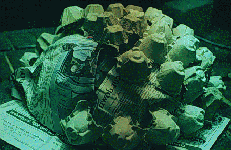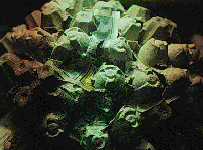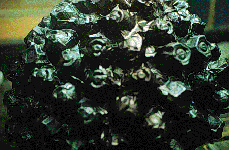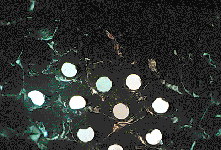
University of Kentucky Department of Entomology







Make Your Own Compound Eyeby Stephanie Bailey,
|
 S.Bailey, 1995 | To begin with, cut up the egg cartons into individual 'eyes.' Invert the LARGE mixing bowl, and cover with 1 or 2 layers of newspaper. Using the glue gun, attach individual eyes to each other, or to the newspaper covering the bowl, using the bowl as a mold. The closer together the eyes fit, the better. |
Once the inverted bowl is covered with individual eyes, rip sheets of newspaper into thin strips. In the medium size mixing bowl, mix flour and water into a paste (paper mache). Adding extra glue is optional.
Use the newspaper, dipped in paper mache paste, to fill and smooth out the spaces in between individual eyes. Allow to dry. This may take one to several days. |  S.Bailey, 1995 |
Gently pull the compound eye off of the large mixing bowl. If some of the newspaper in- between sticks, don't worry. Add a layer of paper mache newspaper strips to the inside part of the compound eye, again smoothing out and filling in spaces between the individual eyes. Allow to dry.
 S.Bailey, 1995 | Once the compound eye is completely dry, gently remove from bowl. Cover both surfaces of the eye with at least 2-3 coats of spray paint, in a bright, dark, or metallic color. |
On the inside (concave side) of the compound eye, CAREFULLY hot glue a mirror to the bottom of each individual eye. |  S.Bailey, 1995 |
The compound eye can be displayed with a large easel, or on a shelf. By looking into the compound eye, students can get an idea of what an insect might see.
Related WWW Sites
Photographs courtesy of S. Bailey, University of Kentucky Department of Entomology
Last updated: 21 January 1999
 Return to UK Department of Entomology Katerpillars page
Return to UK Department of Entomology Katerpillars page Return to UK Department of Entomology homepage
Return to UK Department of Entomology homepage Return to University of Kentucky homepage
Return to University of Kentucky homepage